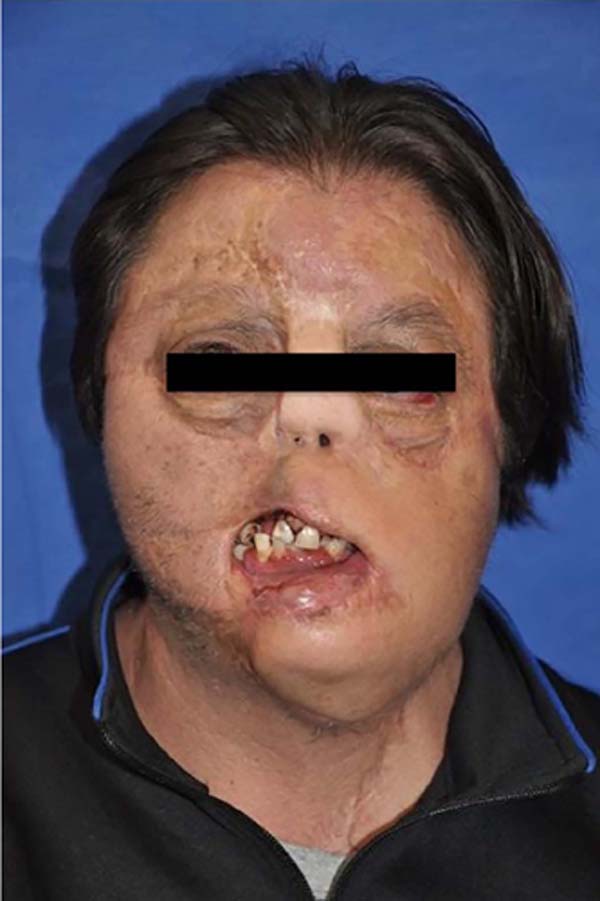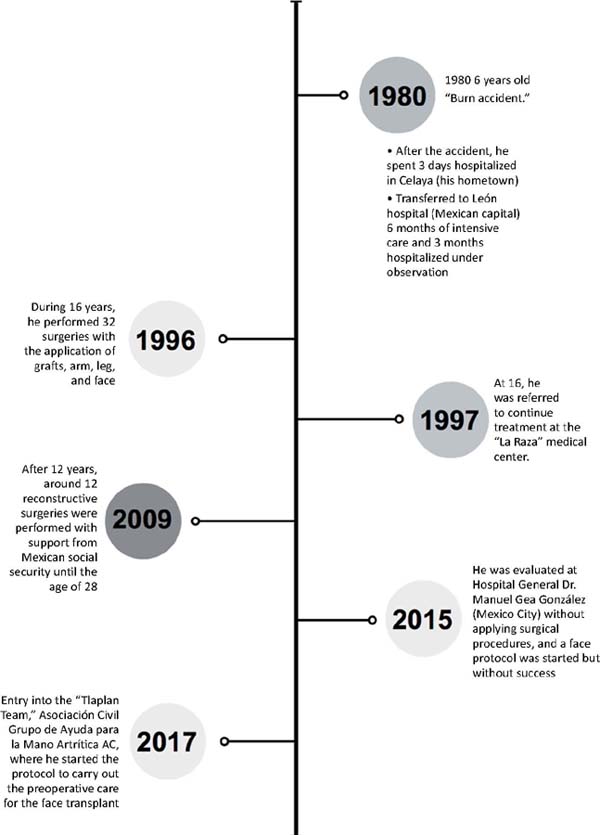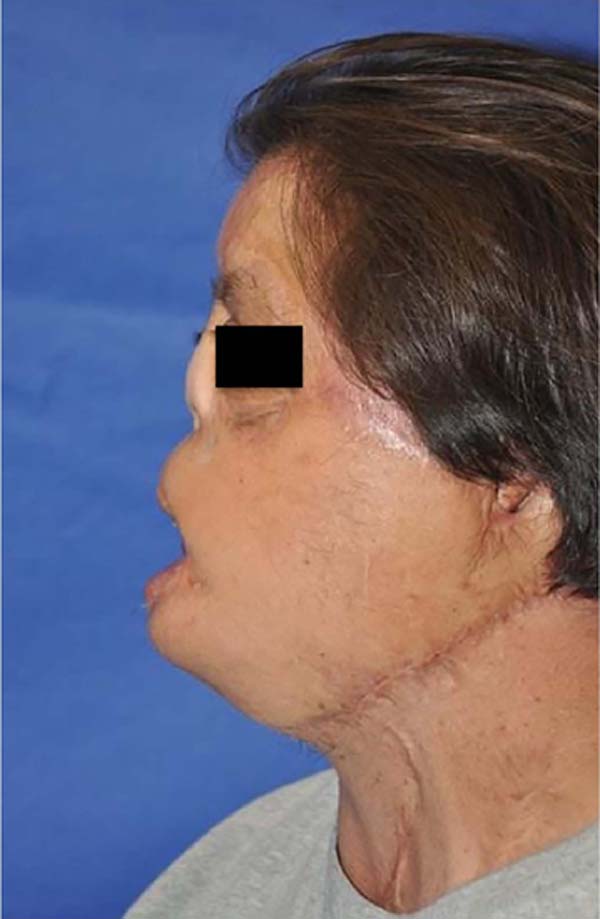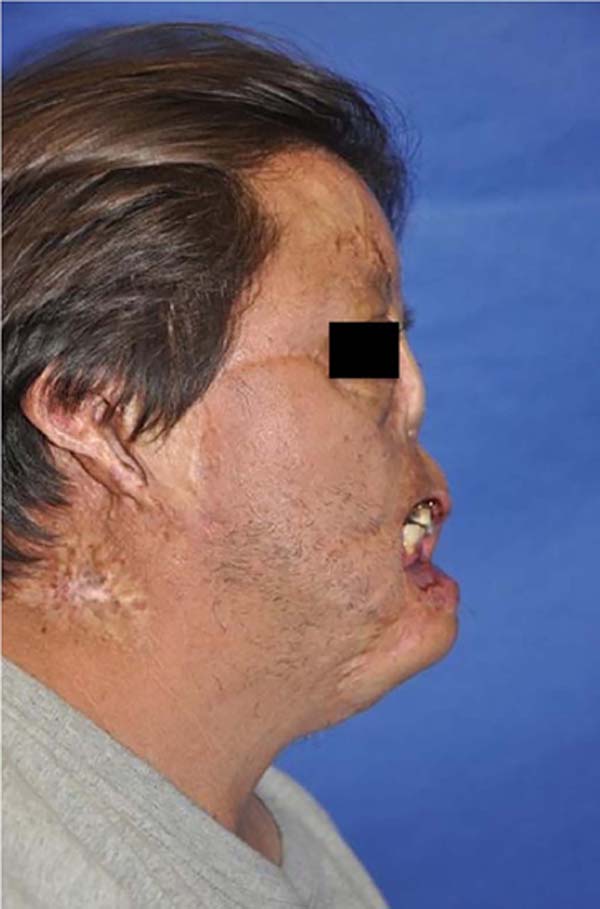INTRODUCTION
Face transplantation has acquired recognition, changing the clinical-surgical panorama
in restoring complex facial defects since it attributes functional and aesthetic recovery.
A study in 2019 in the United States revealed that the incidence of craniofacial injuries
by firearms increased by about 31.7%, that of burns reached 240.2%, and that of animal
attacks to 173.9%1. Thus, the insertion of facial transplantation in medical practice aims to improve
the quality of life, as it reintegrates the functions of swallowing, speech, and the
patient’s psychosocial integration.
In 2005, in Amiens (France), the first partial face transplant was performed after
the patient was affected by an animal attack. Since then, the procedure has been performed
for more than 10 years, seeking surgical improvement, as there is a great clash regarding
the numerous risks and immunosuppression, making this procedure, for many, something
experimental with unfinished ethical questions, such as adherence and psychological
maturity, risks of opportunistic infections and malignancies due to extensive tissue
exposure2.
To perform the transplant, the degree of health of the patient and their comorbidities
are taken into account, in which the main method of choice for surgeons is vascularized
composite allotransplantation (VCA). It refers to the transplant that includes the
three embryological layers of multiple tissues in a functional unit, such as muscle,
bone, nerve and skin, subcutaneous tissue, blood vessels, and tendons; being from
a deceased donor to a recipient with a severe injury, tolerating only a limited period
of ischemia, with the rapid establishment of blood flow3.
Adequate revascularization and the functional and aesthetic reintegration of the surgical
process are the ultimate goals to be achieved with facial transplantation. However,
the major obstacle still being faced is immunosuppression due to the need to change
numerous structures on the face and in adjacent areas, making long-term pharmacological
use almost inevitable, with potentially fatal side effects, which requires a rigorous
medical assessment concerning risk-benefit3,4.
In official publications, at the time of writing this article, 43 patients have already
undergone facial transplantation, with only five deaths due to complications of non-adherence
to medication, the appearance of tumors, trauma, neoplasms, or unknown cause4. Face transplantation has numerous pieces of evidence that can irrefutably provide
improvements to the patient. Thus, it becomes relevant to carry out the present work,
which aims to describe an experience of a candidate for facial transplantation in
Mexico City - Mexico, in addition to conducting a discussion with an emphasis on preoperative
clinical management.
CASE REPORT
Identification
ASM, male, 46 years old, brown, with a high school education, works in a company that
manufactures sports uniforms, with residence in Celaya, Mexico.
History of current illness (HDA) (Figures 1 and 2)
Figure 1 - Patient with face and neck showing multiple healed transverse flaps and depressed
lower eyelids, without mobility and with multiple scars.
Figure 1 - Patient with face and neck showing multiple healed transverse flaps and depressed
lower eyelids, without mobility and with multiple scars.
Figure 2 - Timeline of current illness history.
Figure 2 - Timeline of current illness history.
He reported no visual acuity complications but with the presence of epiphora and bilateral
ectropion. Concerning hearing, he denied alterations, with the absence of the left
ear and half of the right ear, intact tongue, and difficulty swallowing fluids. He
had a loss of nose, with predominantly oral breathing. He had sequelae from burns
and surgical reconstructions on his face, with unstable skin.
After an initial evaluation with the plastic surgeon, he underwent a multidisciplinary
analysis, namely: specialist in Transplants; Psychiatry; Psychology; Social work;
Anesthesiology; Infectology; Occupational Therapist; Neurology; Cardiology; Dentistry;
Oral and maxillofacial surgeon; Ophthalmologic Oculoplastics; Urology; Otolaryngology;
Internal medicine; Bioreproduction and Nutrology.
Personal Physiological Background (PPB)
History of 44 surgeries in total and 35 blood transfusions.
Pathological Personal History (PPH)
Diagnosed with type 2 diabetes mellitus in 2017, controlled with metformin; latent
tuberculosis diagnosed and treated with isoniazid; multinodular goiter with aspiration
biopsy, reporting a hyperplastic nodule and Bethesda II and epidermoid cancer in the
burned area of the right forearm, resected in 2017.
Life Habits
Former alcoholic discharged from rehabilitation treatment in 2017. He denies smoking.
General Physical Examination (GPE)
The patient was in good condition, conscious and oriented in time and space, with
indifferent attitude and decubitus, facies with changes secondary to facial burn.
Patient with severe limitation of movement of the left hand and other extremities
with cicatricial lesions.
Orofacial Clinical Examination (OCE)
The skin flap that replaced the nose has two orifices, the left of which is permeable
with a flattened shape in a microstoma aspect (resembles the nostrils of a fish) (Figure 3). The atrophic upper lip with a thin red border. The hypertrophic lower lip with
multiple scars, both rigid, which prevent manual traction to visualize the labial
vestibules.
Figure 3 - Left side view.
Figure 3 - Left side view.
The malpositioned right maxillary second molar turned inwards partially. Maxillary
dental arch with dental crowding. Generalized gingivitis. The right anterior dentoalveolar
process is protuberant and exposed outside the mouth.
It has gingival retraction, with lingual root exposure on the right second molar (Figure 4). Other regions analyzed in the buccal area without other alterations. He has Angle
class I malocclusion with a crossbite. The maximum oral cavity opening of 3.6 cm is
not painful.
Figure 4 - Right side view.
Figure 4 - Right side view.
Specialty Assessments (SA)
Ophthalmology
The patient reports chronic lacrimation. Upper eyelids with mild dermatochalasis.
Lower lid of the right eye with severe tarsal ectropion; Lower left eyelid with retraction.
Anterior lamina of the eyelid with a skin graft. 5mm lagophthalmos bilaterally. The
cornea with fine dots, a photo-reactive iris, transparent lens.
Psychology
He has the intellectual resources necessary for efficient decision-making, allowing
him to be voluntarily and responsibly involved in this transplant protocol. No evidence
of symptoms of depression or anxiety. He has stabilized cognitive capacity concerning
his physical image (face).
In addition, one of the required criteria is applying a Stanford Integrated Psychosocial
Assessment form for Transplantation (SIPAT). It is identified as a high risk of rejection,
infection, and mortality. A score greater than 42 is considered incompatible with
a successful transplant. However, ASM was considered psychologically adequate for
being below the value.
Donor preoperative plan
In the frontal region, the compound flap will be raised subperiosteally until it finds
the origin of the supraorbital nerves. The dissection of the frontal flap will be
continued in its superficial lateral portion of the aponeurosis of the temporal muscle
up to the upper edge of the zygomatic arch. At the neck level, the common carotid,
internal and external carotid, and facial arteries will be identified, as well as
the external and internal jugular vein and facial vein.
The upper eyelid will be dissected bilaterally above the levator palpebrae aponeurosis
in the orbital region.
Elevation of the nasal floor mucosa and the mucosa of the lateral wall of the upper
jaw will be performed. It will be sectioned from the insertion of the nasal septum
of the palatine crest.
Complementary Exams (CE)
Electrodiagnosis and Electromyography
In the functional evaluation of the facial muscles, facial asymmetry was found at
the expense of the right hemiface; on muscle examination, the following classification
was identified (Table 1).
Table 1 - Report of the patient’s electromyography examination performed preoperatively.
| Muscle |
Qualification |
Sensitivity |
| Right |
Left |
Trigeminal Nerve |
| Frontal |
3 |
3 |
|
|
| Eyebrow Corrugator |
2 |
2 |
Preserved ophthalmic branch |
Preserved ophthalmic branch |
| Orbicularis oculi |
2 |
3 |
Preserved maxillary ascending branch |
Preserved maxillary ascending branch |
| Buccinator |
1 |
1 |
Maxillary descending branch preserved |
Maxillary descending branch preserved |
| Nasal wing lift |
2 |
2 |
|
|
| Orbicularis oris |
1 |
1 |
|
|
| Mentonian |
2 |
2 |
|
|
| Platysma |
3 |
3 |
|
|
Table 1 - Report of the patient’s electromyography examination performed preoperatively.
Assessment of facial movement according to House and Brackmann (1985) presenting grade
I V, being moderately severe dysfunction with normal symmetry and tone at rest and
in movement. The frontal region is absent, the eyes with incomplete closure, and the
asymmetrical mouth with maximum effort.
Echocardiogram (January/2019)
Systolic function with an ejection fraction of 68% and impaired systolic dysfunction
with a type I filling pattern.
Carotid and vertebral Doppler ultrasound (January/2019)
Presence of common carotid artery, internal and external carotid artery with regular
walls; thickness of the intima and media layer in normal parameters, not being identified
atheromatous plaques or stenotic lesions. Doppler demonstrates anterograde flow and
maintains its settings, velocities, and resistance index within normal parameters.
Vertebral arteries with anterograde flow and velocity in normal parameters. A tracing
of the jugular and external veins is also performed, in which permeable veins with
an adequate flow are observed.
Laboratory tests (January/2020) (Table 2)
Table 2 - Laboratory tests performed by the patient in the preoperative period.
| Exams |
Result |
Exams |
Result |
| Glycemia |
106 mg/dl |
Hematocrit |
45% |
| Erythrocytes |
5.10 106/mm3 |
Hemoglobin |
15.2 g/dl |
| Leukocytes |
5,295 mm3 |
Segmented |
68% |
| Platelets |
155,000 mm3 |
AST |
38 U/L |
| Glycated hemoglobin |
6.2% |
ALT |
58 U/L |
| Urea |
29.96 mg/dl |
GGT |
93 U/L |
| Serum creatinine |
0.73 mg/dl |
Prothrombin time (TAP) |
12s |
| Serum sodium |
140.0 mmol/L |
Activated partial thromboplastin time (APTT) |
31s |
| Serum potassium |
4.2 mmol/L |
Hbsag |
Negative |
| Serum chlorine |
105.0 mmol/L |
Anti-HCV total |
Non-reactive |
| Serum calcium |
11.33 mg/dl |
Anti HAV |
Negative |
| Serum phosphorus |
1.9 mg/dl |
Anti HIV |
Non-reactive |
| Uric acid |
7.45 mg/dl |
Anti-hepatitis D |
Negative |
| Total cholesterol |
145 mg/dl |
C-reactive protein Ultrasensitive |
1.59 mg/dl |
| Direct bilirubin |
0.21 mg/dl |
Anti Epstein Baar Ag capsid VCA IgM |
1.56 index |
| Indirect bilirubin |
0.34 mg/dl |
Anti-Epstein Baar Ag capsid VCA IgG |
4.56 index |
| Creatine phosphokinase (CKMB) |
26 U/L |
Cytomegalovirus IgG |
Negative |
| Globulin |
4 gr/dl |
toxoplasma IgG |
Negative |
| Lactic dehydrogenase (LHL) |
240 U/L |
|
|
Table 2 - Laboratory tests performed by the patient in the preoperative period.
DISCUSSION
Among the 43 cases already published, in which 13 patients had trauma etiology from
extensive burns, only 28 mentioned some management guidelines regarding the pre-transplantation
period. In addition, only one study correlates the necessary preoperative care and
its applications in the context of immunizations necessary to perform the procedure5.
In general, before transplantation, patients report depressive symptoms and changes
in quality of life. In this way, potential candidates undergo a psychosocial assessment.
As in the report, the patient can perform his daily activities6.
Caring for these patients offers unique challenges, including immunosuppression, allograft
rejection, and impaired communication. ASM underwent a strict screening established
by the protocol, identifying new comorbidities that influenced the delay of such a
procedure.
The patient was chosen because he was a victim of a burn accident, with 72% of his
body surface burned, with more than 40 surgeries without significant progress. According
to the American Society of Plastic Surgeons (SACP) and the Society for Reconstructive
Microsurgery (SMR), facial transplantation should be performed in patients with severe
facial dysfunction, with a loss greater than 25% and after exhaustion of conventional
techniques with results unsatisfactory. Therefore, the patient continues to be able
to perform preoperative management7.
Furthermore, due to the extent and depth of the burns on the central units of the
face, the patient is using a nasal prosthesis in addition to presenting occlusion
of the nasal passage, which is reflected in the change in his sleeping habits and
the appearance of sinusitis in the left maxillary sinus.
This was similarly demonstrated in two patients who had an exposed nasal cavity with
airway occlusion before the transplant and required a prosthetic nose. After facial
transplantation, although there was no significant improvement in sleep disturbance,
there was a successful restoration of the airways, nasal breathing without obstacles,
and the disappearance of sinusitis after some surgical corrections due to the alignment
of the donor’s septum7,8.
Inadequate characteristics such as immunosensitization, neuropathology, and adverse
reactions represent obstacles to performing surgery. What was not identified in the
report, as it presented complete stability in the evaluations and without reactional
manifestations8.
Similar to the reported case, a patient who underwent a face transplant was found
with the same orofacial characteristics, in which, after the transplant, there was
a return of facial agraphesthesia and motor improvements after the 6th month9.
Laboratory monitoring of fasting blood glucose and glycated hemoglobin is of great
importance in the patient already has type 2 diabetes mellitus, one of the early complications
found in post-transplant patients: transient diabetes9. A patient with a similar clinical picture was identified, who evolved positively
with drug treatment after transplantation.
The negative reaction to the cytomegalovirus immunological test was a preponderant
factor for management since it influences the degree of allograft dysfunction and
patient morbidity and mortality. The mechanism is still unclear, but all patients
who developed such an infection were successfully treated with antiretroviral therapy10.
Multiprofessional strategies are launched because of the complexity of this procedure
and its repercussions in the pre- and post-surgical phases.
Currently, the patient is in the stabilization phase under control of diabetes mellitus
and systemic arterial hypertension, identified during the preoperative period, necessitating
the postponement of the procedure. In addition, he is waiting for a compatible donor.
CONCLUSION
A case on the preponderant care for a facial transplant was detailed. Although there
is little medical knowledge in Brazil, this is a reality in many developed countries,
where the patient manages to enable the return of his skills and facial expressions
with a potentially natural appearance.
Furthermore, laboratory and multidisciplinary follow-up within the scope of the preoperative
evaluation over a long period is essential since it increases the possibility of detecting
possible comorbidities, and they are resolved before the surgical procedure.
It is important to publicize this innovative procedure in different medical specialties
and preoperative care through a thorough investigation, enabling the recovery of their
facial identity once stigmatized.
1. Grupo de Ayuda para la Mano Artrítica AC, “Tlalpan Team”, Medicina, Tlalpan, Cidade
do México, Mexico
2. Centro Universitário do Estado do Pará (CESUPA), Medicina, Belém, Pará, Brazil
Corresponding author: Mateus de Sousa Borges Rua Municipalidade, 985, sala 2112, Umarizal, Belém, PA, Brazil. Zip code: 66050-350
E-mail: mateus.sousa.borges@hotmail.com


















